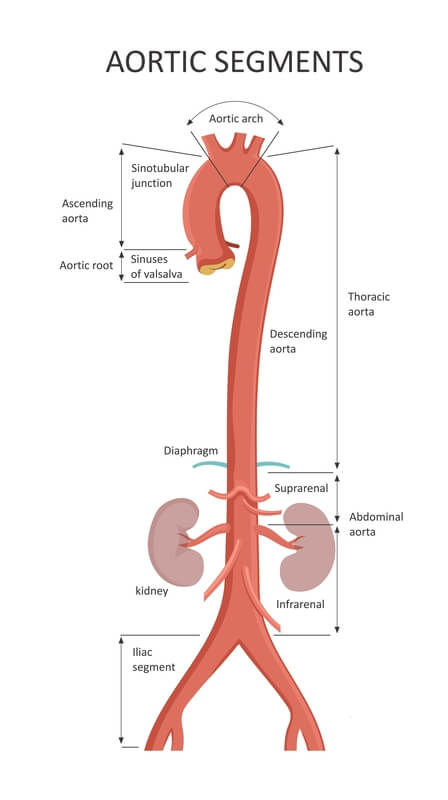
An aortic aneurysm occurs when the walls of the aorta weaken and bulge outwards, causing life-threatening internal bleeding. The aorta is the largest blood vessel in the body that carries blood from the heart through the center of the chest and torso.
The diameter of the aorta is usually between 2 and 3 cm. It can bulge beyond 5 cm in case of an aneurysm.
An aneurysm’s size and speed of growth determine treatment options, varying from annual monitoring to emergency surgery. An aortic aneurysm is a serious condition that usually needs immediate medical intervention.
An aneurysm is a bulge or ballooning in a blood vessel caused by a weak spot in the blood vessel wall. This phenomenon is most commonly seen at points where the blood vessel branches. As blood passes through the weakened blood vessel, the blood pressure causes a small area to bulge outwards like a balloon.
An aortic aneurysm occurs in the aortic artery, which carries blood to all major organs in your body, including the heart, brain, kidneys, liver, and intestine.

The aorta has four parts:
An aortic aneurysm can result in dissection or rupture of the aorta. An aortic dissection occurs when the layers of the aortic wall are split, and blood flows between these layers. An aortic rupture occurs when the aneurysm bursts and causes bleeding inside the body. Both conditions can be life-threatening.
An aortic rupture or aortic dissection is the main complication of an aortic aneurysm. Both conditions cause life-threatening bleeding. The larger the aneurysm and the faster it grows, the higher the risk of a tear in the arterial wall. If an aneurysm ruptures, you are likely to experience:
Aortic aneurysms can also cause blood clots to form. These blood clots can then break off from the aortic wall and travel elsewhere in your body, causing a blockage in your blood vessel.
Aortic Aneurysms can occur in the chest (thoracic aortic aneurysm) or the abdominal area (abdominal aortic aneurysm). Thoracic aortic aneurysms are less common than abdominal aortic aneurysms.
A thoracic aortic aneurysm occurs in the part of the aorta that travels through the chest cavity.
Causes
Causes for thoracic aortic aneurysm include:
Symptoms
A thoracic aortic aneurysm tends to grow slowly, and there may be no obvious symptoms indicating its presence till it becomes large enough for concern. As the aneurysm grows, you may notice some signs of it:
An abdominal aortic aneurysm occurs below the chest, in the part of your aorta that passes through your abdomen. It tends to occur more commonly in men than in women.
Causes
Although there is no clear cause for abdominal aortic aneurysm, doctors have identified some causes for it:
Symptoms
Like thoracic aortic aneurysms, abdominal aortic aneurysms do not show clear symptoms. However, if you have any of the following signs, it could be a sign that you have a growing abdominal aortic aneurysm.
At Sydnor Cardiac Center, Dr. Lilian Ahiable will review your medical and family history along with your lifestyle habits during your cardiology consultation to determine if you are at risk for an aortic aneurysm. Aortic aneurysms are usually diagnosed using X-rays, echocardiograms, CT scans, or ultrasounds.
If an aneurysm is identified, the doctor will make a decision about surgical intervention based on your specific situation. If the aneurysm is small, it may be enough to monitor its growth during your annual checks. However, if the aneurysm is large, you might need surgery or a stenting procedure to treat it.
An aortic aneurysm can become a life-threatening problem if left unmonitored. Entrust your care to Dr. Ahiable and the team at Sydnor Cardiovascular Center.
To schedule an appointment, call us at 727-300-2282 or request an appointment online.